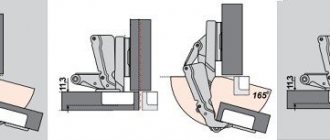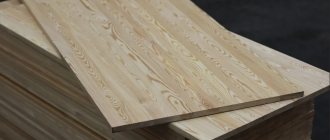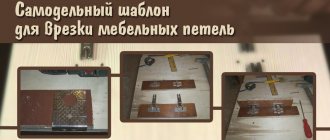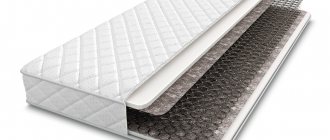5635 0 1
Icer April 27, 2018Specialization: master in the construction of plasterboard structures, finishing work and laying floor coverings. Installation of door and window units, finishing of facades, installation of electrical, plumbing and heating - I can give detailed advice on all types of work.
Today we will figure out how to make your closet more convenient to use using a device such as a pantograph. This is a special system that allows you to raise and lower the bar under the hangers at the moment you need. Thanks to this design, compartments with clothes can be located in the upper part of the closet, freeing up space below for shelves.
Pantograph is a very convenient element in modern clothing storage systems
What is a pantograph and how does it work?
What is pantorgaf? This is a device designed for storing clothes in the under-ceiling space of a wardrobe at an inaccessible height. Helps save space and makes it easier to take out and hang clothes.
The pantograph is most often used for storing things in wardrobes
All pantographs are a U-shaped or L-shaped structure, which consists of several parts:
- Barbell. All models offer a sliding rod, the size of which can be adjusted to fit the width of the cabinet. Clothes are hung on it.
- Side levers. These are the load-bearing elements that hold, raise and lower the barbell. They come with two or one side fastenings.
- Lifting mechanism. Provides movement of levers. This is a system of springs, hydraulics or gas shock absorbers, which is housed in plastic casings. Electrically driven devices are also available.
- Lever. Attached to mechanical models for pantograph control.
The principle of operation is simple: by pulling or pushing the handle, you can lower and raise the bar with hanging clothes to the required height. Electric drives are controlled by a button or remote control.
Ancestor
Like many other objects, the pantograph has a “parent”. It was Christophe Scheiner. He was a German astronomer, physicist, mathematician and mechanic. At one time he joined the Jesuit Order.
Initially, Sheiner became famous in astronomy, and then in other sciences. He became the inventor of many useful devices. For example, he worked on a telescope with two convex glasses, based on Kepler's developments. He also created two drawing tools: a device for drawing conic sections and a pantograph. This discovery was largely fundamental for the development of other similar mechanisms.
Advantages and disadvantages
In most cases, a pantograph helps improve the quality of life. But it also has disadvantages.
Advantages:
- makes it easier to find, get and hang things in the closet;
- improves ventilation: clothes are fresher;
- makes it easier for older people and people with disabilities to get things;
- frees up the lower part of the cabinet for additional shelves;
- reduces the need for ironing: you can hang more clothes than in a regular closet.
Judging by the reviews, breakdowns occur on average after 3-4 years.
The main disadvantage is wear and tear over time. Gradually, backlashes form between the structural parts, which disables the entire mechanism.
It is almost impossible to repair individual parts of the pantograph; the entire system has to be replaced.
This design is inferior to a conventional horizontal hanger bar, which can last forever
Another drawback is the possible creaking of parts during operation. This becomes a problem if the closet is located in a shared bedroom. Compared to a regular bar, pantographs are significantly more expensive and require more complex installation.
How to choose
Most stores offer mechanical models, prices for which start at 2,000 rubles. Depends on the material, load capacity, type of lifting mechanism and manufacturer.
Prices for electric elevators are tens of times higher, even for models with similar characteristics.
What to look for when choosing:
- Material. Steel parts are durable, aluminum parts last less. The plastic must be highly durable.
- Load capacity.
Focus on the average weight of clothing. If it exceeds the load-carrying capacity of the device, then failure in a short time is inevitable. It is better to purchase models with a load capacity of 12, 15, 18 kg, with the exception of small sections of the cabinet. - Type of lifting mechanism. It is better to choose pantographs with gas and hydraulic lifting mechanisms. These lifts have a soft ride and will last longer than spring mechanisms.
- Manufacturer. Models from Chinese manufacturers are cheaper, but they creak more often, do not work stably, and are poorly fixed at the lower level. According to testing results, the highest quality ones are from the following manufacturers: SERVETTO, VIBO, AMBOS.
- Control type. In this matter, they focus on the budget. Of course, electrical devices are more convenient than mechanical ones.
- Bar sizes. The dimensions of the rod are indicated on each model. When choosing, they are guided by the width of the cabinet section where the pantograph will be mounted. The bar should be positioned freely between the walls and not touch the doors while moving. The removal of the rod outside the cabinet is also taken into account. This is important when space is limited.
You can learn about the actual service life and problems of a particular model from consumer reviews. Pay attention to the warranty period from the manufacturer. The larger it is, the better the quality of the device.
Completion of work
The next step is to assemble the copying mechanism for the router. To do this, you need to prepare the following components:
Rulers should be made of plexiglass or plastic, their thickness should be 4-5 mm. You can also use plexiglass as a material for making rulers. Next, the marking of these linear parts is carried out. This process should be approached very carefully, since the slightest error in dimensions can lead to incorrect operation of the pantograph.
https://youtube.com/watch?v=g0binzQzcGg
Holes are drilled on the marked markings. In this case, their alignment must be maintained. To achieve this, you need to put all the rulers together and drill holes in them at the same time.
Then you need to insert brass bushings into the prepared holes. When installing them, a slight tension should be observed: this will help the bushings to stay more tightly in the rulers. In order to secure the axial parts in the bushings, you need to make special clamps. They can be made from hardened steel wire, the diameter of which should be 1-1.5 mm.
Then the boss is assembled. Blind holes are made in its lower part, which can be punched with a core. The nails must be installed in such a way that they protrude from the body of the boss by 2-3 mm.
Having prepared all the necessary parts of the pantograph, they are assembled.
During this process, you need to ensure that all moving parts move smoothly and easily.
https://youtube.com/watch?v=SVsRQZG4HDc
In this case, all prepared holes should be marked. According to this marking, you can scale the manufactured copy of the part.
Make it for school
Pantograph
This simple drawing device can be used to redraw plans, drawings, geographical maps or decorative elements, increasing or decreasing their scale by 1.5, 2 and 3 times.
The device is a parallelogram formed by four planks - two long and two short, made of well-planed hardwood (oak, beech or birch). The planks are connected to each other with screws and nuts
Pay attention to the screw (view B) - it is of an unusual type. With its lower rounded head it rests on the table surface, thus unloading node A, with which the pantograph is attached to the lid
If the device is used to obtain a copy on an enlarged scale, a guide pin is fixed in node B - it can be a blunt nail clamped into a collet pencil, and a regular pencil, felt-tip pen or ballpoint pen is fixed in node B. By tracing the lines of the original with a pin, we will obtain a copy of the specified magnification scale on paper. To obtain a copy in a reduced form, the guide pin and the writing instrument are swapped. To select the scale, holes are provided in the long and short bars and a digital designation is entered, the ratio of reduction or increase.
Clamping pins are most easily made from a piece of rubber in the form of flat washers. The holes in the washers should be cut so that the collet pencil and writing instrument fit tightly into it.
A clamp is provided to secure the device to the workbench. It must be made from a steel plate 1.5 mm thick. To prevent the clamp from scratching the table top, cut a 2 mm thick rubber gasket under it. There is a hole on the upper plane of the clamp into which the pantograph axis is inserted. As you can see, there is no bearing here. Therefore, to reduce friction between parts, install washers.
In the figure, the numbers indicate: 1 - clamp, 2 - rubber gasket, 3 - table cover, 4 - long strap, 5 - short strip and 6 - rubber clamps.
Types of pantographs
Pantographs can be mechanical or electrical.
All models are divided by material of manufacture:
- steel;
- aluminum.
By rod width:
- 450 - 600 mm;
- 600 - 800 mm;
- 800 - 1150 mm;
- other parameters;
Pantographs are also designed for different load capacities. The kit comes with instructions and mounting hardware.
Mechanical
Mechanical pantograph
These are easy-to-install and operate devices. Lifting mechanisms are gas, hydraulic and spring.
| Mechanical models | ||||
| Manufacturer, model | SERVETTO ONLY | AMBOS 700 | VIBO Ambrogio | LEMAX |
| Lifting mechanism | hydraulic | hydraulic | hydraulic | hydraulic |
| Section width | 600-1200 mm | 750-1150 mm | 500-750 mm | 600-830 mm |
| Rod type | telescopic | telescopic | telescopic | sliding |
| Load capacity | 12 kg | 15 kg | 14 kg | 12 kg |
| Material | steel, plastic | chrome steel, plastic | steel, plastic | metal, plastic |
| Color | grey, brown | white | grey | silver |
| average price | 9100 rub. | 6200 rub. | 7050 rub. | 3250 rub. |
Electrical
Electric pantograph SERVETTO
Controlled by a button connected by a wire to the system unit or remote control. Much more convenient to use, but require complex installation by a qualified electrician. Electrically driven pantographs are generally made to order.
Characteristics of the SERVETTO ELECTRICAL model (made to order).
| Manufacturer country | Italy, SERVETTO |
| Lifting mechanism | electric drive, connection to 220 v network |
| Control | remote controller |
| Section width | 830-1150 mm |
| Rod type | telescopic |
| Material | nickel, plastic |
| Color | black |
| Load capacity | 15 kg |
| Average price with delivery | 59,000 rub. |
To order an electric pantograph, you need to contact manufacturers' representatives. This can be done through the official websites.
Pantographs are indispensable for all tall cabinets and dressing rooms - they help to properly distribute space and maintain order. As for the main drawback - wear and tear - this can be prevented. To do this, purchase models from trusted manufacturers and adequately evaluate price and quality. Durable materials, good workmanship and reliable mechanisms cannot be very cheap.
Rules for designing cabinet functionality
Review of rollers for wardrobes, how to choose the right one
A properly designed closet can replace an entire dressing room, which is very important if the dimensions of the room are limited and there are a lot of things to store. Therefore, we invite you to familiarize yourself with the key elements of the cabinet functionality and the rules for their implementation.
- Rack for clothes.
An indispensable element that is used to store long items such as dresses, outerwear, etc. The distance from the rod to the top shelf should be at least 40-50 mm. The optimal width of hanger hangers is 340-510 mm, depending on the clothing.
- Width of sections for clothing.
The smallest cabinet depth is 500 mm, but the most optimal solution would be a cabinet with a depth of 550 mm if you also plan to use a longitudinal rod. In case of designing a shallower depth, an end hanger is used. This is not so convenient, and besides, you should take into account the width of the section, which should not be less than 500 mm, and it is better that it be 550 mm.
If you use the Raumplus, Lex Style or Cinetto systems, then the minimum cabinet depth increases to 600 mm, and 650 mm is considered optimal. This system is also suitable for a cabinet with a shallower depth, but only if you use it to store children's clothes.
- Height of sections for long clothes.
There are the following sections for clothes of different lengths:
- long clothes from 1400 to 1600 mm;
- average length from 1200 to 1400 mm;
- short clothes from 1000 mm;
- trousers with a minimum height of 800 mm.
It is important that the clothes rails are positioned according to its height
Depending on a person’s height, barbells are performed at different heights, for example:
- With a height of 180 cm, the optimal height of the bar will be 2000 mm;
- with a height of 160 cm – 1900 mm.
This information is useful for effectively organizing your closet space. For example, clothes can be placed on “two floors”, men’s clothes are located at the top, and women’s clothes are located at the bottom, or non-seasonal and seasonal clothes are arranged according to the same principle. On average, the width of a standard pair of boots is 250 mm, and the length varies from 300 to 400 mm. When designing shelves, it is necessary to calculate the distance between shoe shelves in such a way as to take into account the height of the backdrops. For boots, additional measurements are taken.
- Shoebox.
Often, in addition to shoes and boots, you also have to store shoe boxes in the closet, in which out-of-season shoes, sandals or boots are either stored, or are planned for storage.
- Ironing board.
Ironing boards can be made in various sizes. The most popular is 1550x390 mm. For such a board it is necessary that the width of the compartment be at least 200 mm. It is best to initially measure the board in order to design the niche as accurately as possible. Remember, there are no ordinary ironing boards, vacuum cleaners, or sewing machines; each model is different in some way.
- Drawers.
The optimal height for retractable structures is considered to be up to 1100 mm from the floor. However, they are not particularly convenient to use if you plan to store a lot of things in them.
The distance from shelf to shelf should be within 320 mm. This rule is relevant not only for things, but also for books. The optimal width is 400 mm or more. 400 mm is a European standard that is actively used all over the world.
- Rules for constructing tables.
They come in different types: dining, work, desk, toilet, but the optimal height for each of them is the same - this is 750 mm to the top of the tabletop.
For a desktop, the depth should be 600 mm. An important parameter in the design process of a desktop is the width of the seat, which should be more than 700 mm.
source











